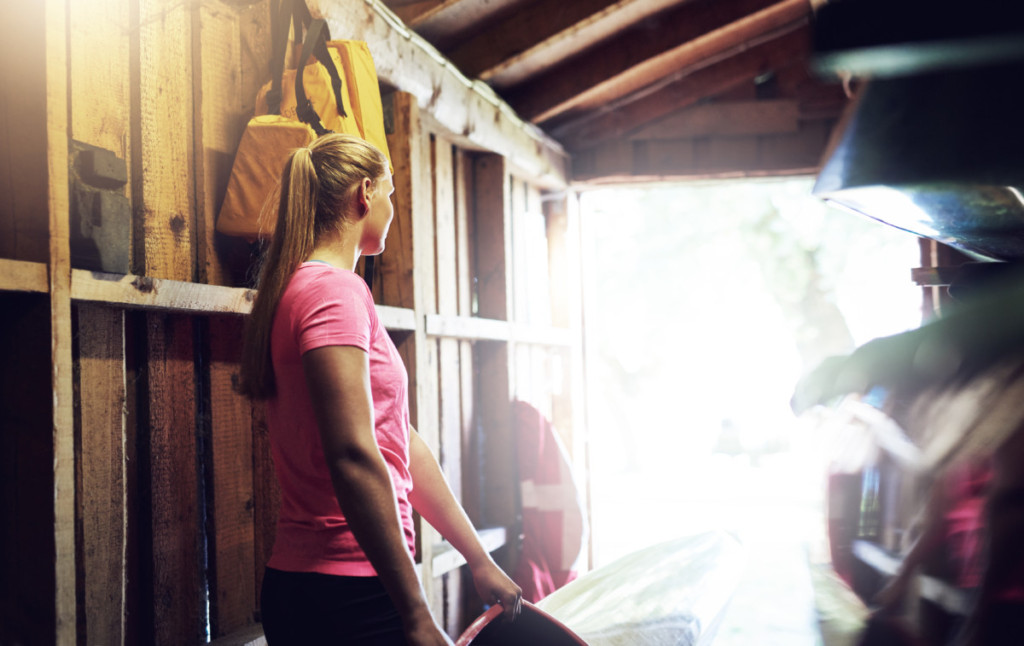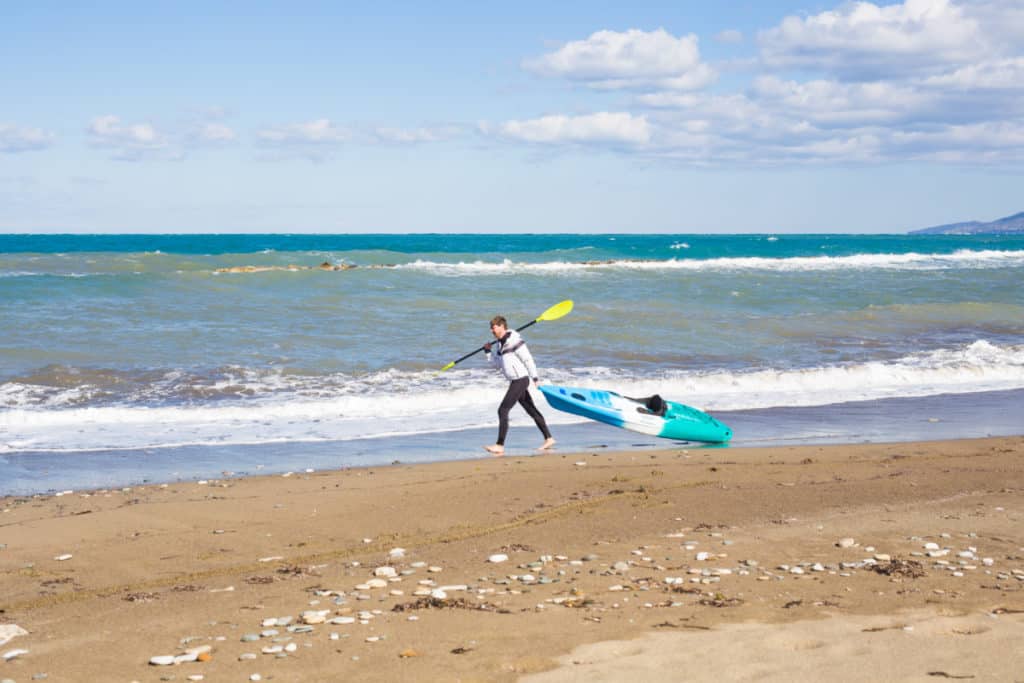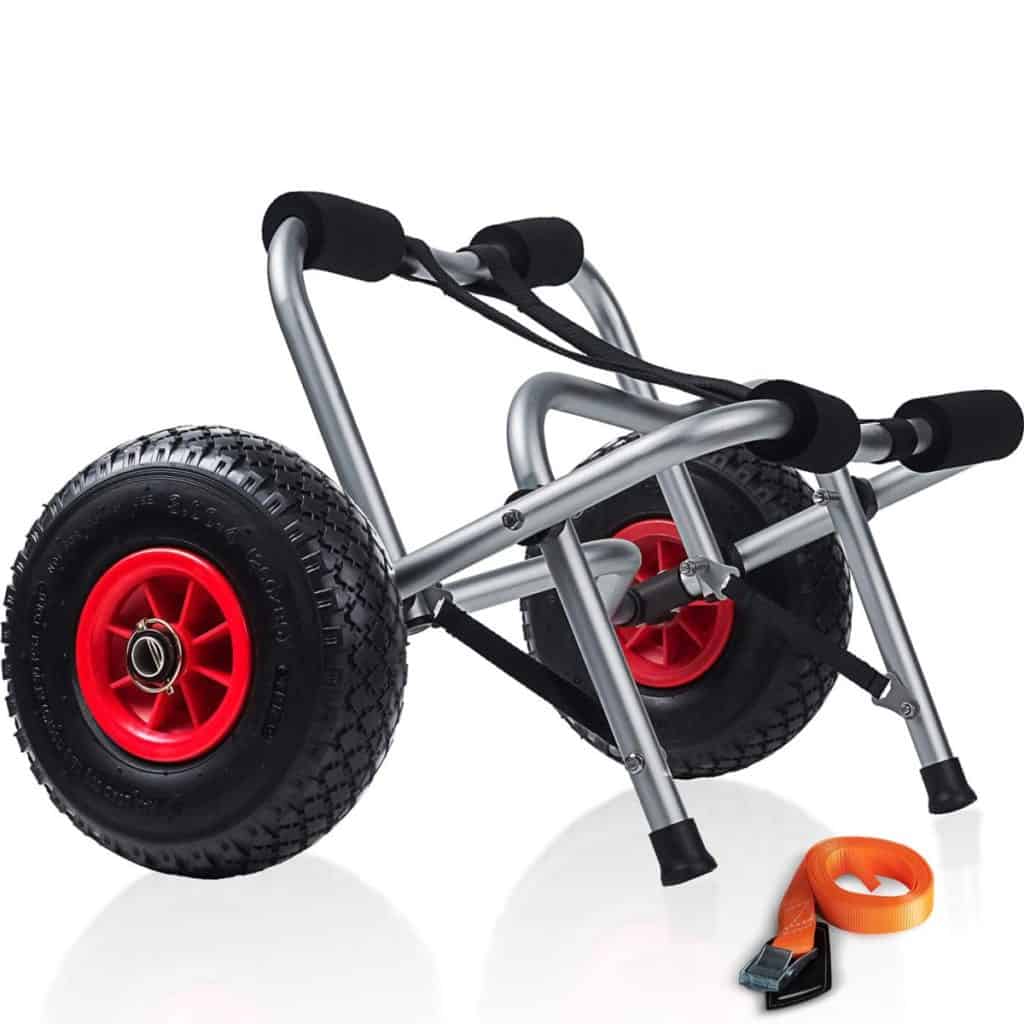
One has to seriously consider how much their fishing kayak is going to weigh before making the purchase. Some kayaks weigh over 100lbs (45kg)!! There is no way youʻre strapping that thing to the roof of your car without some help. So, what is the average weight of a fishing kayak?
In short, the average kayak weighs 55lbs (25kg) unloaded. The additional weight of all your fishing gear once stowed onto the kayak can add as much as 25lbs (11kgs). Therefore, the total average weight of a fully equipped fishing kayak is roughly 70lbs-80lbs (31kg-36kg).
This figure can change dramatically based on the length, construction materials, width and gear that you pack for your fishing expedition. Weʻll get into that in a bit.
But first, here is a chart with some of the most popular fishing kayaks and their corresponding weights based on manufacturer specifications.
| TRADITIONAL KAYAK | Length | Kayak Weight | Max Carry Weight |
|---|---|---|---|
| Ocean Kayak ʻMalibu” | 9ʻ5” | 54lb | 325lb |
| Ocean Kayak ʻMalibu” | 11ʻ5” | 59lb | 360lb |
| Ocean Kayak “Malibu Peddle” | 12ʻ | 100lb | 400lb |
| Pelican ʻTrailblazerʻ | 10’ | 36lb | 275lb |
| Pelican ʻSprintʻ | 12ʻ | 51lb | 325lb |
| FISHING KAYAKS | |||
| Prowler 13 ʻAnglerʻ | 13ʻ4” | 56lb | 325lb |
| Prowler Big Game II Angler (Rated most stable boat) | 12ʻ9” | 70lbs | 325lbs |
| Hobie Mirage 12ʻ | 12ʻ | 105lbs | 500lb |
| Hobie Mirage 14ʻ | 13ʻ8” | 120lbs | 144lbs |
Why Your Kayakʻs Weight is Important?
There are 3 main reasons why the weight of your kayak should be heavily considered before making your purchase.
The number one reason is you donʻt want to purchase a kayak that is too heavy for you to handle. If you are unable to carry your kayak to the water or lift it onto the racks of your car, itʻs not doing you much good. You must be able to transport your kayak, even if that means using a trailer or carrying it yourself.

Another reason why the weight of your kayak is important is that you donʻt want it to be too heavy for the roof racks of your car. I have a Toyota Sienna that we use as a family car. We usually go camping in this car and there is no way I am leaving behind my fishing kayak if weʻre going to be anywhere near water.
Thing is, the roof racks are only rated to hold 100lbs. If I was to choose a Hobie Mirage or a similar kayak that is just as heavy, Iʻd have to think about alternative transportation options. New racks? Maybe a Trailer? Iʻd rather just use what I got, so I stuck with a smaller boat in the 60lb range.
Iʻve added more information regarding this and other methods of transporting your kayak a little bit later in this article.
Last reason I think considering the weight of your kayak is important is because of conditions. My local fishing grounds are off the coast of Hawaiʻi and the winds can change on a dime. I remember going out fishing only to find myself in gale force winds a half hour later.
If I had one of those featherweight boats I donʻt think I wouldʻve made it home. I felt a lot more secure in the heavier boat I was in, I even had a blast riding the wakes all the way home. This time, a little extra weight was my friend.
What Materials are Kayaks made from?
Of course, the materials your kayak is made out of will affect the weight of your kayak.
ROTOMOLDED KAYAKS
Most average fishing kayaks are considered Rotomolded Kayaks. A plastic (polyethylene) is poured into a mold and heated, forming a one-piece kayak composite.
These are the cheapest boats to build but are also the heaviest. They can also be a little harder to maneuver around in the water due to their weight. Rotomolded kayaks are some of the toughest on the market. They can handle shallow rocky areas with only minor scuffs.
The plastic does breakdown in UV light, so it is best to store it in a shady place out of the sun. If these kayaks do get a hole in them, repairs can be problematic. I have seen a few youtube videos using old plastic milk jugs to seal small holes, but in my experience, that never lasts long.
WOOD KAYAKS
Wood is another common material used for making kayaks. This method is usually reserved for the backyard boat builder or for someone who has the money to pay someone else to make it.
By mixing a thin wood veener, a layer of fiberglass and resin, wood boats can be made to be even stronger than their graphite/kevlar counterparts. However, they are prone to damage, so no white water river runs, keep it to calm lakes or sandy beaches.
GRAPHITE/KEVLAR COMPOSITE
Kayaks made with a mixture of fiberglass, graphite and kevlar layered on a mold to form a kayak tend to be the lightest on the market. These materials are also super strong, allowing them to be very resistant to damage. If they do get damaged, the repair is fairly straightforward and can even be done in the field.
These kayaks are also some of the fastest on the market due to the stiffness of the hull. With all these advantages, why not choose a kayak made of composite materials? For most people itʻs the price. These boats start off in the $1000ʻs and go up from there.
INFLATABLE KAYAKS
The last type of kayak weʻll discuss is inflatable kayaks. These kayaks are becoming increasingly popular. They are super easy to travel with and are fairly lightweight. They are made from a strong poly-based fabric that gives them their strength and rigidity.
The problem with these as a fishing kayak is that they donʻt allow for much gear storage. Iʻd also be worried that it would not stand up to the rigors of fishing. I could only imagine popping the kayak way out to sea. No Thanks.
Short vs Long Kayaks
When looking to save weight, one can instantly think that a shorter kayak is lighter, which is true btw.
But, and this is a big but, shorter kayaks lose stability. Stability is pretty important for a fishing kayak. You have a lot of gear on board and do not want to go tipping your boat and risk losing some of it. And what would happen if you hooked a big fish and were not ready for it? You might be swimming thatʻs what. They have less storage space, leaving fewer options for extended kayak trips but can be fine if you only plan on going out on day trips.
Another tradeoff between a short and a long kayak is the speed in which they travel. A longer kayak equals a longer hull which equals a faster boat.
Longer Kayak = Longer Hull = Faster Boat
The long hull displaces more water, leading to a smoother, faster ride in the water. But with that comes maneuverability. A shorter kayak is more maneuverable, but longer kayaks make up for this with the addition of rudders.
Transporting Your Fishing Kayak
A very common way for people to transport their kayaks is on the top of their car. Many cars come with factory-installed roof racks that can carry most kayaks. Generally, smaller cars with factory installed roof racks like a Subaru or minivan have racks with a 100lb weight limit. Larger SUV type cars have roof racks rated to hold 150lbs.
That said, you may want to think twice about buying a 100+lb kayak if you plan on transporting it with a Toyota Minivan. You can get around this problem by purchase aftermarket roof racks like Thule or Yakima. They are usually rated as low as 150lbs with some going up to 500lbs carrying capacity..
It can also be difficult getting a heavy kayak onto the roof of your car. My kayak is 60lbs, I have no problem lifting it up there. Sometimes Iʻm feeling a bit lazy though. Thatʻs when Iʻll lift one end of the boat onto a rack, then lift the other end and push and shimmy it on to the roof racks.
The drawback to transporting your kayak on the roof of your car is that you have to remove most of the gear from the kayak before putting it onto the roof of your car.
An even better way to transport your kayak would be in the back of a truck. A 10ʻ kayak should have no problem sticking out the back of a small pickup bed. You could also transport it with the tailgate down and add a bed extender to your trailer hitch to be able to carry any length kayak.
If that still doesnʻt work for you, a trailer can be a great option for transporting kayaks. The drawback to this method is the expense of the trailer, license fees, parking fees and more. With this method and by transporting your kayak in the back of your truck, you can leave much of your gear in place on your kayak allowing for easier loading and unloading, which equals more fishing time.
Weʻve figured out how to get your kayak from your house to the water, but sometimes the only way to get your kayak that last 100 feet or so requires you to carry it down the trail the rest of the way.
A kayak cart is a great way to get your kayak to where you want it. A kayak cart is made of 2 wheels that get placed under your kayak that allow it to be easily rolled from place to place.
This especially comes in handy when youʻve geared up your kayak next to your car only to realize the water is 100 yards away.
Now you donʻt have to break your back.

